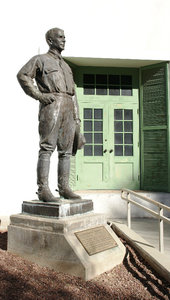Advertisement
Published: April 10th 2013

 JOHN CAMPBELL GREENWAY
JOHN CAMPBELL GREENWAY
This is a replica of the statue placed in the Hall of Statuary in the U S Capitol. It stands in front of the Arizona Historical Society Musum in Tucson.JOHN CAMPBELL GREENWAY
Each of the 50 states is allowed two entries in the Hall of Statuary in the US Capitol. The notables selected for that distinction from the State of Arizona are the Jesuit priest Father Eusebio Kino, and John Campbell Greenway. Padre Kino would probably be surprised at such an honor because he was not in Arizona very long. Just long enough to leave footprints for other missionaries to follow before he died at Magdalena in 1711. Missionaries who came later brought the church to our heathens and introduced European style agricultural techniques that flourished along the Santa Cruz River Valley. Kino’s influence on those improvements was huge and the native inhabitants along the river flourished. Sadly enough John Greenway has about drifted into historical obscurity. He was born in Huntsville, Alabama on July 6, 1872 and gobbled up his education at the Phillips Academy in Andover, Massachusetts, then onward to the University of Virginia and finally graduating from the Sheffield Scientific School at Yale in 1895. He worked briefly for Carnegie Steel but joined the Rough Riders during the Spanish American War. He was awarded the Silver Star for gallantry in action at

 LAVENDER PIT
LAVENDER PIT
This is the open pit mine in Bisbee. John Greenway wasn't involved in this project, but Calumet Arizona was. The Lavender Pit shows pretty much everything that could be done wrong in the open pit mining method. San Juan Hill and was brevetted to captain by Teddy Roosevelt. After the war he went to work for U S Steel and supervised development of the Canisteo open pit iron ore mine and the Trout Lake Washing Plant at Coleraine, Minnesota. Trout Lake was the largest iron beneficiation plant in the world at the time it opened in 1911. U S Steel had branched out to copper production by then due to the urgent need to provide electrification to America. Greenway joined the staff of the Calumet and Arizona Mining Company to develop the copper resources at Ajo. It was to be the first open pit copper mine in the world. By 1916 he had become a regent at the University of Arizona in Tucson but answered the call to arms again when the United States finally entered WWI. He served with brave distinction at the Battle of Cambrai, France in 1918 and was promoted to colonel in the Arizona National Guard in 1919. Three years later, in 1922, he was promoted to brigadier general and took as his bride a widow woman named Isabella that he had first met in 1911. The happy couple returned to Ajo where

 ARIZONA INN
ARIZONA INN
This is the hotel that Isabella built in 1930. One of its functions was to provide an outlet during the Great Depression for the furniture built at the Arizona Hut by veterans disabled in WWI. The Inn is still the Gem of Tucson. Greenway had become a mining executive with Calumet-Arizona. In 1926 Greenway died in New York City of complications arising from a surgical procedure. The statue went up in 1930. What Greenway had given to the State of Arizona was the open pit mining method. It has provided thousands of good jobs and produced billions of dollars in revenue. He was a dashing military hero, and Isabella was proud of his statue, but she really ought to have a statue of her own. Isabella was born on the Dinsmore Farm in Boone County, KY on March 22, 1886 and died of heart failure in Tucson on December 18, 1953. After John Greenway died she sold his accumulated mining stock and bought a ranch up near Williams that she expanded to 130,000 acres. She owned and operated Gilpin Airlines in Los Angeles for a while, then sold it to build the Arizona Inn in Tucson. She built the Inn to support the Arizona Hut, which was a facility for the manufacture of furniture by disabled veterans. She was a staunch veteran’s activist, got elected to Congress in 1932, and served two terms. At age 50 she retired from politics. Isabella was a

 INSPIRATIONAL WOMEN PANEL
INSPIRATIONAL WOMEN PANEL
A few years back a monument to women was built at the University of Arizona. It is a ring of interconnected columns that looks sort of like a crown. Isabella tops the list of Inspirational Women of Arizona. Clara Fish Roberts is also recognized on his panel. Clara was the first female to graduate from the University of Arizona. She later became an educator and the first female member of the school board. Clara was Grampa Bill's first cousin. lifelong friend of Eleanor Roosevelt, was a bridesmaid at Eleanor’s wedding to FDR, and was godmother to their only child, Anna. When FDR ran for President Isabella was running for Congress and gave a speech seconding his nomination at the Democratic National Convention. Generally Isabella supported the New Deal program for economic recovery, but diverged when FDR proposed cutting VA benefits, and she did not think that Social Security could possibly be a sustainable program.
Advertisement
Tot: 0.395s; Tpl: 0.015s; cc: 8; qc: 41; dbt: 0.2219s; 1; m:domysql w:travelblog (10.17.0.13); sld: 1;
; mem: 1.1mb

 JOHN CAMPBELL GREENWAY
JOHN CAMPBELL GREENWAY
 LAVENDER PIT
LAVENDER PIT
 ARIZONA INN
ARIZONA INN
 INSPIRATIONAL WOMEN PANEL
INSPIRATIONAL WOMEN PANEL
